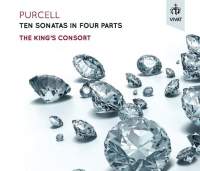Texte paru dans: / Appeared in: |
|
|
|
|
|
Reviewer: Bertil
van Boer In 1697 Henry Purcell’s wife Frances began publication of some of her late husband’s theater works, along with these 10 four-part string sonatas, some of which he himself no doubt had intended for distribution before his death. She was in need of funds to maintain herself and her children, and as Purcell was already recognized as the leading English composer of the time, striking while the iron was hot had its advantages. These works were not his first publications of instrumental pieces, for in 1683 he had already had 12 trio sonatas printed. At that time, he actually had a separate fourth part book for the keyboard also printed, which in effect made the three parts into four, thus separating the cello (or whatever instrument was called upon to be part of the continuo group). It may well be that this new set had hung around in Purcell’s music cabinet since that time, though this is not entirely clear. In any case, these works are every bit as carefully crafted and interesting as their Italian counterparts by composers such as Archangelo Corelli. The early instrument group King’s Consort has rearranged the rather strange and disorganized order of the original 1697 edition, which, as the excellent booklet notes state, was quite sloppily done. This includes replacing the ninth sonata, entitled “Golden” (though for what reason seems unfathomable), as the fifth or central work, a rearrangement that seems more consistent with Purcell’s own sense of key structure. The goal of the set seems to be arriving at the G-Minor Chaconne (Sonata Z 807), an extremely complex work in which the violins have a wonderfully chromatic dance with some rather difficult harmonies emerging from the linear musical construction. The brief imitative lines also add to the technical complexity as they appear and meld back into one another in a seemingly random pattern (all held together, of course, by the ostinato bass line). The result is kaleidoscopic. The “Golden” Sonata itself is like an aria (and one finds foreshadowings of Handel therein), with some hemiola in the beginning movement that suddenly and without warning plunges into a lament in the minor, an insertion of an emotional moment with a descending line that has varied chromatic colors. This makes the contrast with the final movement with its jaunty line all the greater. Here one finds string fanfares, as if the play’s happy conclusion were heralded. Here, too, a poignant lament intrudes before a final contrapuntal section based upon a sprightly dance tune. How “golden” one wishes to see the title piece may be a matter of personal interpretation, but there can be no doubt that the dramatic content must have been somewhat apparent, particularly since both violins trail off, as if the actors were leaving the stage. I find echoes of Dido’s Lament in the second ostinato ground of the B-Minor Sonata (Z 802), as if this were a sketch (if done earlier than the opera) or mnemonic remnant (if composed later) for that iconic piece. Purcell’s sense of intricate counterpoint abounds, especially in movements such as that second one of the A-Minor Sonata (Z 804). The performance of the King’s Consort instrumentalists is clear and precise. The instruments are completely matched, and the occasional alteration of the harpsichord and organ seems perfectly logical. The theorbo continuo is extremely discrete, and this allows the vigorous playing of the bass viol by Susanne Heinrich to stand out (as Purcell intended). She handles the often rolling lines with decided ease, being the perfect complement to the two violins. In short, this is a fine disc. The playing is in tune and in tempo, with an excellent sense of ensemble. These works were formerly released by the Purcell Quartet some years ago, as well as an older London Baroque disc from two decades ago, but this set supersedes them by a considerable degree. I would get this one for your collection, as it sets a new standard. | |
|
|
|
|
|
|
|
Cliquez l'un ou l'autre
bouton pour découvrir bien d'autres critiques de CD |
|




